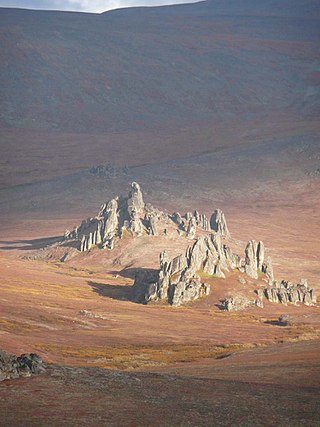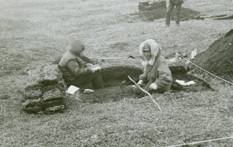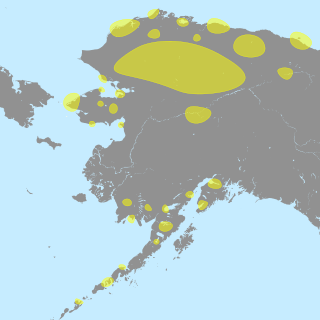
The Iñupiat are a group of Alaska Natives whose traditional territory roughly spans northeast from Norton Sound on the Bering Sea to the northernmost part of the Canada–United States border. Their current communities include 34 villages across Iñupiat Nunaat, including seven Alaskan villages in the North Slope Borough, affiliated with the Arctic Slope Regional Corporation; eleven villages in Northwest Arctic Borough; and sixteen villages affiliated with the Bering Straits Regional Corporation. They often claim to be the first people of the Kauwerak.
The Thule or proto-Inuit were the ancestors of all modern Inuit. They developed in coastal Alaska by the year 1000 and expanded eastward across northern Canada, reaching Greenland by the 13th century. In the process, they replaced people of the earlier Dorset culture that had previously inhabited the region. The appellation "Thule" originates from the location of Thule in northwest Greenland, facing Canada, where the archaeological remains of the people were first found at Comer's Midden.
The Paleo-Eskimo were the peoples who inhabited the Arctic region from Chukotka in present-day Russia across North America to Greenland prior to the arrival of the modern Inuit (Eskimo) and related cultures. The first known Paleo-Eskimo cultures developed by 2500 BCE, but were gradually displaced in most of the region, with the last one, the Dorset culture, disappearing around 1500 CE.

St. Lawrence Island is located west of mainland Alaska in the Bering Sea, just south of the Bering Strait. The village of Gambell, located on the northwest cape of the island, is 50 nautical miles from the Chukchi Peninsula in the Russian Far East. The island is part of Alaska, but closer to Russia and Asia than to the Alaskan and North American mainland. St. Lawrence Island is thought to be one of the last exposed portions of the land bridge that once joined Asia with North America during the Pleistocene period. It is the sixth largest island in the United States and the 113th largest island in the world. It is considered part of the Bering Sea Volcanic Province. The Saint Lawrence Island shrew is a species of shrew endemic to St. Lawrence Island. The island is jointly owned by the predominantly Siberian Yupik villages of Gambell and Savoonga, the two main settlements on the island.

The Birnirk culture was a prehistoric Inuit culture of the north coast of Alaska, dating from the 6th century AD, to the 12th century AD The Birnirk culture first appeared on the American side of the Bering Strait, descending from the Old Bering Sea/Okvik culture and preceding the Thule culture; it is distinguished by its advanced harpoon and marine technology. A burial mound of the Birnirk culture was discovered in the town of Wales, Alaska; 16 more have been found in Utqiagvik at the "Birnirk site," which is now a National Historic Landmark. An ancient Birnirk village has been found at present-day Ukpiaġvik.

Cape Krusenstern National Monument and the colocated Cape Krusenstern Archeological District is a U.S. National Monument and a National Historic Landmark centered on Cape Krusenstern in northwestern Alaska. The national monument was one of fifteen new National Park Service units designated by the Alaska National Interest Lands Conservation Act (ANILCA) of 1980. It was initially declared a national monument under the authority of the Antiquities Act by President Jimmy Carter on December 1, 1978.

The Bering Land Bridge National Preserve is one of the most remote Protected areas of the United States, located on the Seward Peninsula. The National Preserve protects a remnant of the Bering Land Bridge that connected Asia with North America more than 13,000 years ago during the Pleistocene ice age. The majority of this land bridge now lies beneath the waters of the Chukchi and Bering Seas. During the glacial epoch this bridge was a migration route for people, animals, and plants whenever ocean levels fell enough to expose the land bridge. Archeologists disagree whether it was across this Bering Land Bridge, also called Beringia, that humans first migrated from Asia to populate the Americas, or whether it was via a coastal route.
The Paleo-Arctic Tradition is the name given by archaeologists to the cultural tradition of the earliest well-documented human occupants of the North American Arctic, which date from the period 8000–5000 BC. The tradition covers Alaska and expands far into the east, west, and the Southwest Yukon Territory.

Cape Espenberg is a cape located on the Seward Peninsula in Alaska, on the Chukchi Sea coast.
Based on archeological finds, Brooman Point Village is an abandoned village in Qikiqtaaluk Region, Nunavut, Canada. It is located in the central High Arctic near Brooman Point of the Gregory Peninsula, part of the eastern coast of Bathurst Island. Brooman was both a Late Dorset culture Paleo-Eskimo village as well as an Early Thule culture village. Both the artifacts and the architecture, specifically longhouses, are considered important historical remains of the two cultures. The site shows traces of Palaeo-Eskimo occupations between about 2000 BC and 1 AD, but the major prehistoric settlement occurred from about 900 to 1200 AD.

The Ipiutak site is a large archaeological site at Point Hope in northwest Alaska, United States. It is one of the most important discoveries in this area, competing only with Ekven, Russia.

The Iyatayet site is an archaeological site and National Historic Landmark located on the northwest shore of Cape Denbigh on Norton Bay in Nome Census Area, Alaska. It shows evidence of several separate cultures, dating back as far as 6000 B.C. It was excavated starting in 1948 by J. Louis Giddings, the pioneering archaeologist of the area. It is significant as the type site of the Norton culture, representative of human occupation c. 500BCE-500CE, first described by Giddings in 1964. It is also significant for the Denbigh Flint complex, which lay underneath the Norton materials, and provides evidence of some of the earliest human activity in the region. The site was declared a National Historic Landmark in 1961.

The Onion Portage Archeological District encompasses a major archaeological site in Kobuk Valley National Park in northwestern Alaska. The site is a deeply stratified site, at which archaeologists have located nine complexes ranging dating from approximately 6500BC to AD1700. The site has been of critical benefit for the study of Arctic cultures, and is used to determine the cultural chronology of the region.
Eduard Dallmann was a German whaler, trader, and Polar explorer.

The Wales Site, whose principal component is the Kurigitavik mound, is a well-documented archeological site on the Cape Prince of Wales, near Wales, Alaska. This site has artifacts from the Birnirk culture as well as the first discovery in Alaska of the later Thule culture. The site was designated a National Historic Landmark in 1962 for its archaeological significance.

Commercial whaling in the United States dates to the 17th century in New England. The industry peaked in 1846–1852, and New Bedford, Massachusetts, sent out its last whaler, the John R. Mantra, in 1927. The Whaling industry was engaged with the production of three different raw materials: whale oil, spermaceti oil, and whalebone. Whale oil was the result of "trying-out" whale blubber by heating in water. It was a primary lubricant for machinery, whose expansion through the Industrial Revolution depended upon before the development of petroleum-based lubricants in the second half of the 19th century. Once the prized blubber and spermaceti had been extracted from the whale, the remaining majority of the carcass was discarded.

The bowhead whale is a species of baleen whale belonging to the family Balaenidae and is the only living representative of the genus Balaena. It is the only baleen whale endemic to the Arctic and subarctic waters, and is named after its characteristic massive triangular skull, which it uses to break through Arctic ice. Other common names of the species included the Greenland right whale, Arctic whale, steeple-top, and polar whale.

Old Bering Sea is an archaeological culture associated with a distinctive, elaborate circle and dot aesthetic style and is centered on the Bering Strait region; no site is more than 1 km from the ocean. Old Bering Sea is considered, following Henry B. Collins, the initial phase of the Northern Maritime tradition. Despite its name, several OBS sites lie on the Chukchi Sea. The temporal range of the culture is from 400 BC to possibly as late as 1300 AD. Another suggested range is from about 200 BC to 500 AD.

The similar cultures of peoples across the Bering Strait in both Siberia and Alaska suggest human travel between the two places ever since the strait was formed. After Paleo-Indians arrived during the Last Glacial Period and began the settlement of the Americas, a second wave of people from Asia came to Alaska around 8000 BCE. These "Na-Dene" peoples, who share many linguistic and genetic similarities not found in other parts of the Americas, populated the far north of the Americas and only made it as far south as Oasisamerica. It is suggested that by 4000–3000 BCE Paleo-Eskimo peoples began coming to the Americas from Siberia. Eskimo tribes live today in both Asia and North America and there is much evidence that they lived in Asia even in prehistory.

The Denbigh Flint complex was a Paleo-Inuit material culture that was active in Alaska and northwestern Canada from 4,000 to 3300 years ago. They were the first members of the wide material assemblage known as the Arctic Small Tool tradition. Sites attributed to the Denbigh Flint complex mostly inhabited northern Alaska from Cape Krusenstern to the western Yukon, but sites are also found further to the south from the Aleutian islands into mainland Alaska. They were mobile hunter-gatherers who relied on caribou herds for sustenance. The Denbigh Flint complex likely were descendants from the Syalakh and Bel’kachi cultures of Siberia. They engaged in wide-scale trade, moving pieces of obsidian over 500km. The economy of the Denbigh Flint complex was based around both maritime and terrestrial resources. They made seasonal visits to the coast to hunt seals, but their primary food was caribou, which they hunted year-round. Denbigh peoples also fished, picked berries, and hunted birds in the fall.















